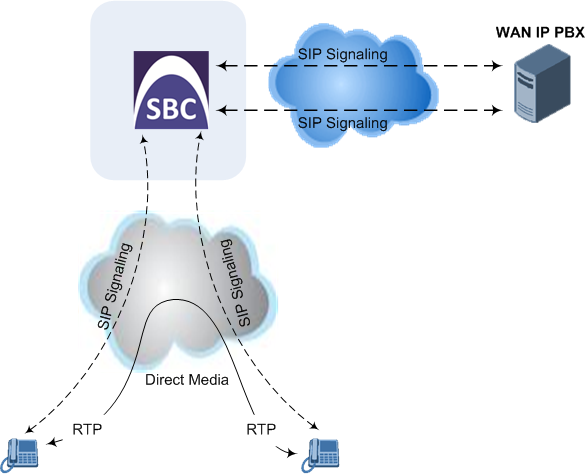Direct Media Calls
You can configure the device to allow the media (RTP/SRTP) session to flow directly between the SIP endpoints without traversing the device. This is referred to as No Media Anchoring (also known as Anti-Tromboning or Direct Media). SIP signaling continues to traverse the device with minimal intermediation and involvement to enable certain SBC capabilities such as routing. By default, the device employs media anchoring, whereby the media session traverses the device, as described in Media Anchoring.
Direct media offers the following benefits:
|
■
|
Saves network bandwidth |
|
■
|
Reduces the device's CPU usage (as there is no media handling) |
|
■
|
Avoids interference in SDP negotiation and header manipulation on RTP/SRTP |
Direct media is typically implemented for calls between users located in the same LAN or domain, and where NAT traversal is not required and other media handling features such as media transcoding is not required. The following figure provides an example of direct media between LAN IP phones, while SIP signaling continues to traverse the device between LAN IP phones and the hosted WAN IP-PBX.

|
➢
|
To enable direct media: |
|
■
|
For all calls: Use the global parameter [SBCDirectMedia], which overrides all other direct media configuration. |
|
●
|
SIP Interface: You can enable direct media per SIP Interface (in the SIP Interfaces table), whereby calls (source and destination) associated with this same SIP Interface are handled as direct media calls. The SIP Interface can also enable direct media for users located behind the same NAT. For more information, see Configuring SIP Interfaces. |
|
●
|
Direct Media Tag: You can enable direct media between users that are configured with the same Direct Media tag value. The tag is configured by the IP Profile parameter 'Direct Media Tag' (see Configuring IP Profiles). |
Regardless of the device's settings for direct media (mentioned in this section), the device always handles calls whose incoming SIP dialog-initiating request (e.g., INVITE message) contains the proprietary SIP header 'X-AC-Action' with the value 'direct-media' (i.e., 'X-AC-Action: direct-media'), as direct media calls. These calls remain as direct media calls until they end. The device doesn’t open voice channels and doesn’t allocate any resources (media ports) for these calls.
The device employs direct media between endpoints under the following configuration conditions (listed in chronological order):
|
1.
|
Direct media is enabled by the global parameter [SBCDirectMedia]. |
|
2.
|
IP Groups of the endpoints are associated with IP Profiles whose 'Direct Media Tag' parameter has the same value (non-empty value). |
|
3.
|
IP Groups of the endpoints have the 'SBC Operation Mode' parameter set to Microsoft Server (direct media is required in the Skype for Business environment). For more information, see Configuring IP Groups. |
|
4.
|
IP Groups of the endpoints use the same SIP Interface and the SIP Interface's 'SBC Direct Media' parameter is set to Enable. |
|
5.
|
IP Groups of the endpoints use the same SIP Interface and the SIP Interface's 'SBC Direct Media' parameter is set to Enable When Single NAT, and the endpoints are located behind the same NAT. |
|
●
|
Direct Media configured for all calls (i.e., using the [SBCDirectMedia] parameter): The device doesn’t open voice channels and doesn’t allocate media ports for these calls, because the media always bypasses the device. |
|
●
|
Direct Media configured for specific calls (i.e., using the IP Profile’s ‘Direct Media Tag’ parameter or SIP Interface’s ‘Direct Media’ parameter): The device always allocates ports for these calls, because these ports may be required at some stage during the call if it changes to a non-direct media call for mid-call services such as early media, call forwarding, call transfer, or playing on-hold tones. Therefore, make sure that you have allocated sufficient media ports (Media Realm) for these calls. |
|
●
|
The following features are not supported for Direct Media calls: |
|
✔
|
Manipulation of SDP data (offer-answer transaction) such as ports, IP address, coders |
|
✔
|
Extension of RFC 2833 / out-of-band DTMF / in-band DTMF |
|
✔
|
All restriction features (Allowed Coders, restrict SRTP/RTP, and restrict RFC 2833) |
|
✔
|
All media-related parameters in the IP Profiles table are not applicable to Direct Media calls |
|
●
|
The device doesn't fully support call transfer (SIP REFER) terminations for direct media calls.
One of the SIP User Agents (UA) in the call must support re-INVITE messages without SDP for the device to synchronize the media.
|
|
●
|
For two users belonging to the same SIP Interface that is enabled for direct media and one of the users is defined as a foreign user (example, “follow me service”) located in the WAN while the other is located in the LAN: calls between these two users cannot be established until direct media is disabled for the SIP Interface. The reason for this is that the device doesn't interfere in the SIP signaling. In other words, parameters such as IP addresses are not manipulated for calls between LAN and WAN (although required). |
|
●
|
If you have configured a SIP Recording rule (see SIPREC SIP-based Media Recording) for calls that have also been configured for direct media, using a SIP Interface ('Direct Media' parameter) or an IP Profile ('Direct Media Tag' parameter), the device automatically disables direct media for these calls (during their SIP signaling setup). This ensures that the media passes through the device so that it can be recorded and sent to the SRS. However, if you enable direct media using the [SBCDirectMedia] parameter (i.e., for all calls), direct media is always enforced and calls will not be recorded. |
